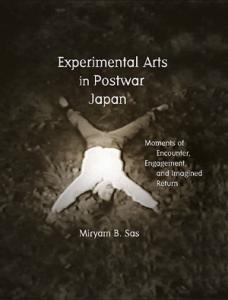Berkeley Books: Experimental Arts in Postwar Japan by Miryam Sas

In the era of rapid economic growth following student-fueled protest movements of the 1960s, artists and intellectuals in Japan repeatedly searched for means of directly expressing and directing the excitement of historical and cultural transformations around them. Yet, despite artists' frequent call for “direct” encounters, their works frequently complicate and dislodge this ideal with instances of interruption, self-reflexive mimesis, and temporal discontinuity. In an era famous for shows of idealism and uproarious activism, some of the most cherished ideals—intimacy between subjects, authenticity, a sense of home—are limitlessly desired yet somehow always just beyond grasp.
This month's Berkeley Books selection, Experimental Arts in Postwar Japan by Professor of Comparative Literature and Film & Media Miryam Sas, explores the theoretical and cultural significance of Japanese experimental arts in a range of media. Focusing on theater, film and video, dance, and then on photography, Sas offers critical readings of the works themselves alongside the artists' writings and manifestos. This dual-sided system of engagement allows Sas to correlate key issues of critical theory to the artists' works, practices, and writings. Sas' approach enables her to enact and sustain a dense dialogue between the cultural concerns of the era and the political and aesthetic implications of these pieces.
Aaron Gerow, Professor of Film Studies and East Asian Languages and Literatures at Yale, writes: "Miryam Sas's new book, Experimental Arts in Postwar Japan: Moments of Encounter, Engagement, and Imagined Return, is a welcome addition to this proliferation of research [on 1960s Japan], focusing not just on experimental cinema, but its larger milieu of the experimental arts, especially post-shingeki theater, butoh dance, and photography."
Sas's previous book, Fault Lines: Cultural Memory and Japanese Surrealism (2001) was praised by the Harvard Journal of Asiatic Studies as a "luminous guiding post, simultaneously pointing toward the past and the future." In addition, she has published numerous articles on Japanese futurism, cross-cultural performance, literature, and butoh dance.
Visit the Biblio-file view books that shaped Professor Sas' thinking while working on Experimental Arts in Postwar Japan.